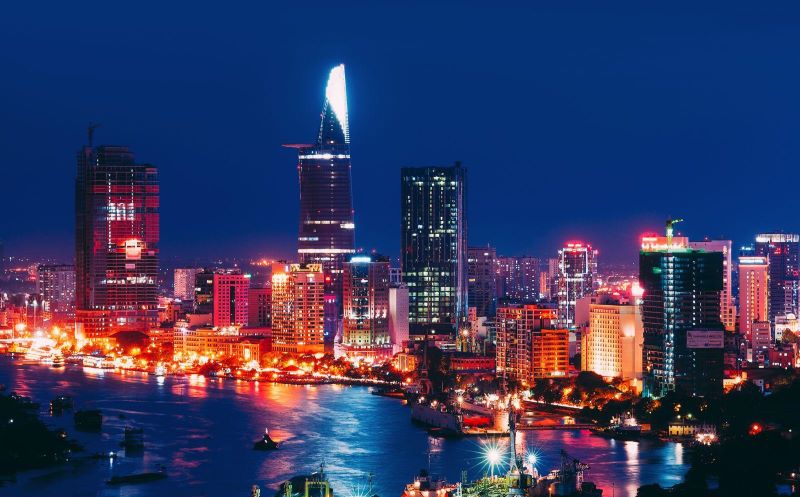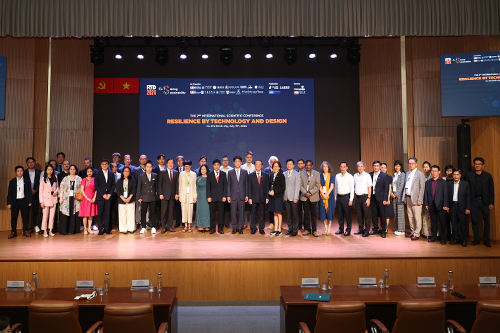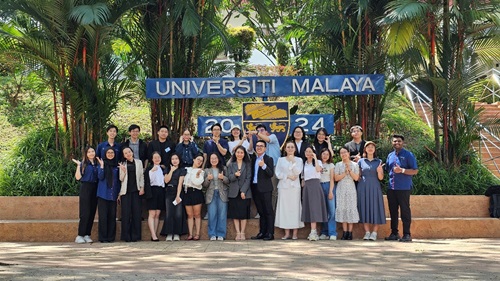[Podcast] The role of science, technology and innovation in effectively mobilizing and using resources to develop the Southern Key Economic Zone (Part 2)
In accordance with the context of the Southern Key Economic Zone and the economic development of Ho Chi Minh City in the period from 2011 to the current time like it was analyzed in the first part, the authors of University of Economics Ho Chi Minh City (UEH) clarified the role of science, technology and innovation in effectively mobilizing and using resources for the development of the Southern Key Economic Zone, proposing further principles in terms of policies towards attracting resources for Regional development.

Collected photo
The role of science, technology and innovation resources
In terms of the socio-economic development strategy, science, technology and innovation has always been considered as the most important basis for speedy and sustainable development.
The development and the application of science, technology and innovation in production labor has always been considered as one of the most important contributing factors to the growth of diverse economies, especially for developing countries. The epochal innovation of the modern economy lies in the widespread application of science and technology to economic production. Concurrently, at the heart of per capita income growth are both technological and innovation changes. Therefore, countries to achieve development goals necessary to perfect the environment of science - technology and innovation towards sustainable economic growth and globalization. Weil (2013) pointed out that “Productivity change contributes to the economic growth of countries sustainably”. As productivity increases, the same amount of production inputs will result in more units of output. One of the main factors that increase productivity is technological improvement and innovation.
With a core role in promoting sustainable economic growth, innovation models need to be systematically designed at the national level to provide a friendly environment for economic individuals to create and to apply new technology, innovative innovation in production and business. Sener & Saridogan (2011) argue that a diversity of factors trigger innovation in technology and creativity in economies. Technological innovation and creativity come from various sources from: companies, universities, local researchers, NGOs, or single individuals and the efforts of society as a whole. In addition, the non-competitive nature of use creates another source of innovation, that is, technology transfer between firms or countries.
In Ho Chi Minh City in particular and in Vietnam in general, it can be identified that science and technology has not affirmed its leading role as the locomotive in production development whereas capacity and technology level is being limited, especially this is more and more difficult in the wave of Industry 4.0. The report from Ministry of Industry and Trade (2021) pointed out a number of barriers and challenges in the development process on the basis of science, technology and innovation in Vietnam, specifically as follows:
• Technology platform is being backward;
• Labor productivity is being low and not entirely based on science, technology and innovation;
• The basic and supporting industries are being too dependent on outsiders;
• In the global value chain, Vietnam is only an intermediary link, a place for processing for export;
• Domestic enterprises are mainly small and medium-sized enterprises, with low competitive advantages compared to foreign-invested enterprises;
• The industrial space has not been fully promoted.
With the purpose of keeping up with the trend of Industry 4.0, digital transformation is inevitable for most countries in the world, including Vietnam. Over the past time, the Vietnamese Government has had many orientations and strategies that have been concretized. Nevertheless, in the implementation process, many barriers and challenges need to be solved as follows:
• The legal corridor and institutional and policy environment are being not tight enough, synchronous and have not kept up with the development of business models in the current digital economy;
• The internal capacity of the Vietnamese economy is facing the big gap with the region in terms of innovation and creativity;
• The readiness of the Vietnam nation for digitization is being low;
• Being in shortage of high-quality human resources;
• Telecommunications infrastructure is being limited;
• Facing the lack of vision on digital transformation;
• Afraid-of-change thinking;
• Limited capacity of the team;
• Limited budget and time constraints.
Some principles suggesting policies to attract development resources
In accordance with these analyses, the authors propose a number of principles and policy suggestions to attract resources for HCMC, focusing on resources, human resources, and land-related policy mechanisms, the rate of budget regulation, revenue fostering, science and technology and innovation as follows:
· With resources for public investment projects, it is necessary to create a strong spillover to stimulate aggregate demand. In particular, the state capital representative agency participates in the implementation of public investment projects with ‘buffer capital’ from the state budget; concurrently, combining and actively seeking and proposing investors from the private regions. It should avoid relying on budget capital but must be flexible and diverse, removing difficulties in forms of payment for investors under the public-private partnership model.
· The role of capital attraction requires the efficiency of state financial investment companies to carry out the construction of socio-economic development works and projects in accordance with the list of infrastructure investment fields. Socio-economic development priority of HCMC for the 2021-2025 period has been issued.
· To attract capital resources, it is necessary to proactively review and adjust land use planning, infrastructure planning for services, industry, high-tech agriculture, port and logistics systems and so on. Completing and renewing the mechanism of land preparation for investors, piloting urban renovation and development projects towards the direction of integration from domestic and foreign resources, from both state and private resources.
· Reviewing backlog projects and potential projects to organize promotion sessions, to collect investment opinions, to call on investors to research and to invest in projects in Ho Chi Minh City’s list; investment promotion in fields, listed as digital economy, sharing economy, circular economy, etc. It is necessary to be proactive in approaching, understanding and supporting partners, large, high-tech corporations for land fund, premises, connection infrastructure, human resources, etc. Focusing on policy dialogue, on-the-spot investment promotion, grasping the situation, and promptly removing difficulties for FDI enterprises that have had and are being in need of investment.
· In order to supplement revenue for the HCMC budget, it is necessary to review the public land fund managed by agencies and units in Ho Chi Minh City. In case of no need to continue using it, the auction plan will be implemented. Concurrently, it is necessary to strengthen land management, to ensure that the land is used for the right purposes and in accordance with the planning. In case of violation of state leased land, it is necessary to consider recovery in accordance with regulations and to organize an auction for avoid waste avoidance.
· To ensure the right, sufficient and timely revenue, it is necessary to strengthen measures to manage and to foster revenue sources, to solve problems in the tax field and to create conditions for production and business establishments to develop. In addition, it is necessary to effectively promote the source of remittances to participate in production and business activities; concurrently, developing a payment-only system and diversifying forms on the basis of technology. Creating policies to encourage remittance of money back home while protecting the legitimate rights and interests of overseas Vietnamese and beneficiaries. In addition, reviewing and evaluating the state of budget revenue and expenditure, thereby, proposing measures to issue local government bonds so as to create more capital for investment.
· Proposals to increase the rate of budget regulation left for HCMC from 2023 onwards to provide resources for HCMC to invest in economic and technical infrastructure, traffic, digitization and so on will help Ho Chi Minh City develop modern and synchronous infrastructure, attract non-state investors, expand hi-tech parks and create new industrial parks with a strategy of attracting public investors. modern industry. It is necessary to continue to exploit the specific mechanism from Resolution No. NQ 54/QH of the National Assembly related to land, equitization, fees and charges and so on.
· Innovating investment policies to attract capital from the private sector for the development of the industry, anticipating investment trends, shifting investment in the industrial sector, especially supply chains industrial goods in the world and in the region. Focusing FDI projects with science, technology and innovation background. Establishing preferential policies on credit, tax, land use, technical infrastructure, use of public services, market facilitation, international relations, copyright registration and intellectual property protection, administrative procedure reform and so on.
· With the goal of becoming a financial center, the most important thing is to create policies and to loosen the restraints on the trend of digital economic development associated with financial inclusion. Concurrently, a pilot mechanism listed as a ‘sandbox’ for technology companies will help the regulator understand and understand how it works and possible risks for products and models from FinTech in particular and a comprehensive financial strategy in general. In which, it is possible to pilot two main groups of digital financial services, including: (1) Digital payment, clearing; (2) Deposits, loans, and capital mobilization (including digital transformation of traditional financial institutions and new models of alternative financial institutions).
· Resources for development of science and technology, innovation, application of high technology and new technologies must be prioritized in order to promote economic restructuring towards rapid increase in service industries with high-productivity knowledge content and high added value. In terms of high-tech parks, it is necessary to promote research, development, training, incubation, start-up and innovation activities, building high-tech endogenous capacity, developing key products in accordance with the shift of direction from outsourcing, assembling, manufacturing, improving added value, and manufacturing.
· The Government should soon implement projects and policies to support businesses in the digital transformation process, applying science and technology, focusing on supporting small and medium-sized enterprises (SMEs) while giving priority to pilot in corporations, large enterprises, information technology enterprises, research and innovation enterprises.
· To ensure economic security in the context of developing socialist market economy and international economic integration, it is necessary to overcome the situation of using investment funds, foreign backyard companies with originated from tax havens and domestic interest groups to invest in real estate companies and projects in Vietnam to dominate and acquire real estate projects. This can lead to market manipulation and illegal money hiding, misleading public opinion in project investment. Strict control is required to ensure safety and transparency in investment activities.
· Training high quality human resources. Focusing on improving human resources in the field of information technology, especially related to network security, artificial intelligence (AI), machine learning, Internet of things (IoT), blockchain, and virtual/augmented reality (VR/AR). The timely addition of this human resource is a decisive factor to catch up with the development of an economy in acordance with science, technology and innovation.
Please refer to full research paper titled The Role of Science, Technology and Innovation in Mobilizing and Effectively Using Resources for the Development of the Southern Key Economic Region TẠI ĐÂY.
Author group: Assoc. Prof. Dr. Nguyen Khac Quoc Bao; MSc. To Cong Nguyen Bao, University of Economics Ho Chi Minh City (UEH).
This is an article in the series of articles spreading research and applied knowledge from UEH with the message “Research Contribution For All”, UEH cordially invites readers to follow the upcoming the Knowledge Newsletter ECONOMY #76.
News, photos: Author Group, UEH Department of Marketing and Communication
Voice of: Ngoc Quy


![[Podcast] Does the Financial Flexibility Prevent Stock Price Crash Risk during COVID-19 Crisis? Evidence from the Vietnamese Stock Market](https://en.ueh.edu.vn/images/upload/thumbnail/ueh-thumbnail-114718-071624.png)
![[Podcast] An Evaluation Of Two Business English Course Books, Business Partner B1+ Business Partner B2: Students’ And Teachers’ Perspectives](https://en.ueh.edu.vn/images/upload/thumbnail/ueh-thumbnail-113649-071624.png)


![[Podcast] Latest approaches for sustainable universities](https://en.ueh.edu.vn/images/upload/thumbnail/ueh-thumbnail-042022-071224.png)